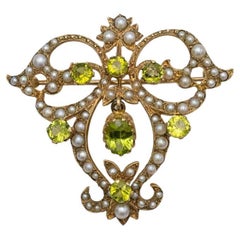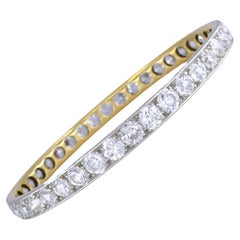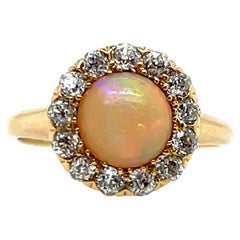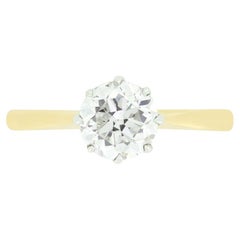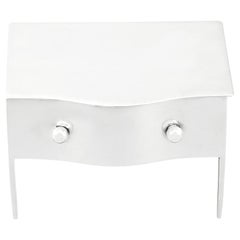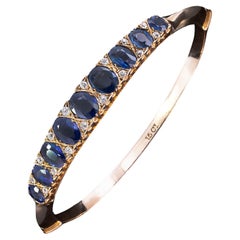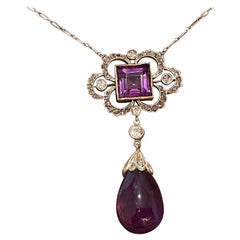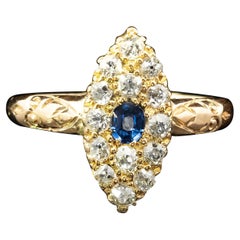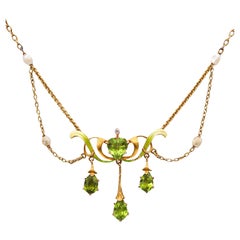Antique Edwardian Jewelry
Early 20th Century British Edwardian Antique Edwardian Jewelry
Pearl, Peridot, Gold, 9k Gold
1910s Unknown Edwardian Antique Edwardian Jewelry
Diamond, Platinum, Gold, 18k Gold, Yellow Gold
Early 20th Century Unknown Late Victorian Antique Edwardian Jewelry
Diamond, Opal, 14k Gold, Yellow Gold
1910s Unknown Edwardian Antique Edwardian Jewelry
Diamond, 18k Gold, Platinum, Yellow Gold
Early 1900s English Edwardian Antique Edwardian Jewelry
Silver, Sterling Silver
Early 1900s Edwardian Antique Edwardian Jewelry
Diamond, Sapphire, 15k Gold
1910s Unknown Edwardian Antique Edwardian Jewelry
Amethyst, Diamond, Gold, 18k Gold, Platinum
Early 1900s Edwardian Antique Edwardian Jewelry
Diamond, Sapphire, 18k Gold
Early 1900s American Edwardian Antique Edwardian Jewelry
Diamond, Pearl, Peridot, White Diamond, Natural Pearl, Gold, Yellow Gold...
Early 1900s North American Edwardian Antique Edwardian Jewelry
Diamond, White Diamond, Sapphire, Blue Sapphire, Gold, Yellow Gold, Pall...
1910s English Edwardian Antique Edwardian Jewelry
Natural Pearl, Pearl, White Diamond, Diamond, Yellow Gold, White Gold, 1...
1810s English Antique Edwardian Jewelry
Diamond, 18k Gold, Yellow Gold
Early 20th Century Dutch Edwardian Antique Edwardian Jewelry
Yellow Gold
Early 20th Century Edwardian Antique Edwardian Jewelry
Pearl, Ruby, 14k Gold
Early 20th Century Edwardian Antique Edwardian Jewelry
Diamond, Sapphire, Yellow Gold
Early 1900s French Edwardian Antique Edwardian Jewelry
Silver, Sterling Silver
Early 1900s French Edwardian Antique Edwardian Jewelry
Yellow Gold, Enamel
Early 1900s Edwardian Antique Edwardian Jewelry
Diamond, 15k Gold
Early 1900s Edwardian Antique Edwardian Jewelry
Diamond, Platinum
1920s Edwardian Antique Edwardian Jewelry
Diamond, Ruby, Gold, 18k Gold, Yellow Gold, Platinum
Early 1900s Edwardian Antique Edwardian Jewelry
Diamond, Sapphire, Platinum
1910s Unknown Edwardian Antique Edwardian Jewelry
Diamond, 18k Gold, Platinum
Early 1900s American Edwardian Antique Edwardian Jewelry
Diamond, White Diamond, Gold, 14k Gold, Yellow Gold, Enamel
Early 1900s American Edwardian Antique Edwardian Jewelry
Diamond, White Diamond, Gold, 14k Gold, Yellow Gold, Enamel
Early 1900s Edwardian Antique Edwardian Jewelry
Diamond, Pearl, 14k Gold, Platinum
Early 1900s American Art Nouveau Antique Edwardian Jewelry
Natural Pearl, Gold, Enamel, 10k Gold, Yellow Gold
Early 20th Century Edwardian Antique Edwardian Jewelry
Diamond, Platinum
Early 1900s English Victorian Antique Edwardian Jewelry
Rose Gold, 9k Gold
Early 1900s American Art Nouveau Antique Edwardian Jewelry
Pearl, Natural Pearl, Gold, Yellow Gold, Enamel, 14k Gold
1910s Edwardian Antique Edwardian Jewelry
Pink Sapphire, Gold, 14k Gold
Early 20th Century English Edwardian Antique Edwardian Jewelry
Aquamarine, Pearl, 9k Gold
Early 20th Century British Edwardian Antique Edwardian Jewelry
Diamond, Amethyst, Natural Pearl, 18k Gold
Early 1900s American Edwardian Antique Edwardian Jewelry
Diamond, White Diamond, Gold, 14k Gold, Yellow Gold, Enamel
1890s English Victorian Antique Edwardian Jewelry
Sterling Silver
Early 1900s American Edwardian Antique Edwardian Jewelry
Pearl, White Diamond, Diamond, Enamel, Yellow Gold, 14k Gold, Gold
19th Century Italian Edwardian Antique Edwardian Jewelry
Amethyst, Gold, 14k Gold, Rose Gold, Yellow Gold, Enamel
Early 1900s American Art Nouveau Antique Edwardian Jewelry
Diamond, White Diamond, Gold, 18k Gold, Yellow Gold, Enamel
Early 1900s Edwardian Antique Edwardian Jewelry
White Diamond, Diamond, Platinum, Yellow Gold, 18k Gold, Gold
1910s French Antique Edwardian Jewelry
18k Gold, Yellow Gold
Early 1900s American Edwardian Antique Edwardian Jewelry
Rock Crystal, Gold, Yellow Gold, 14k Gold
Early 1900s American Edwardian Antique Edwardian Jewelry
Jade, Gold, Yellow Gold, Enamel, 14k Gold
Early 1900s North American Edwardian Antique Edwardian Jewelry
Diamond, Pearl, White Diamond, Natural Pearl, Gold, Yellow Gold, Enamel,...
Early 1900s American Edwardian Antique Edwardian Jewelry
Natural Pearl, Pearl, White Diamond, Diamond, Enamel, Yellow Gold, 14k G...
Early 1900s French Edwardian Antique Edwardian Jewelry
Pearl, Natural Pearl, Gold, 18k Gold, Yellow Gold, Enamel
Early 1900s French Edwardian Antique Edwardian Jewelry
Pearl, Natural Pearl, Gold, 18k Gold, Yellow Gold, Enamel
1910s Edwardian Antique Edwardian Jewelry
Coral, Sterling Silver
1910s Edwardian Antique Edwardian Jewelry
Amethyst, Gold, 14k Gold
Early 1900s Spanish Edwardian Antique Edwardian Jewelry
Diamond, 18k Gold, Platinum
Early 1900s French Edwardian Antique Edwardian Jewelry
Multi-gemstone, Gold, Platinum, Enamel
Early 1900s American Art Nouveau Antique Edwardian Jewelry
Diamond, White Diamond, Gold, 14k Gold, Yellow Gold, Enamel
Early 1900s French Edwardian Antique Edwardian Jewelry
Citrine, Quartz, Gold, 18k Gold, Yellow Gold
Early 20th Century English Edwardian Antique Edwardian Jewelry
9k Gold, Rose Gold, White Gold
Early 20th Century Edwardian Antique Edwardian Jewelry
Amethyst, Pearl, 10k Gold
1910s Swedish Edwardian Antique Edwardian Jewelry
Diamond, Gold, Silver
1910s American Edwardian Antique Edwardian Jewelry
Diamond, White Diamond, Gold, Yellow Gold, Enamel, 18k Gold
1910s American Art Nouveau Antique Edwardian Jewelry
Amethyst, Gold, 14k Gold, Yellow Gold, Enamel
Early 1900s American Edwardian Antique Edwardian Jewelry
Diamond, Turquoise, White Diamond, Gold, White Gold, Platinum, 18k Gold
Early 1900s English Belle Époque Antique Edwardian Jewelry
Diamond, White Diamond, Gold, Yellow Gold, Platinum, 18k Gold
- 1
- ...
Antique Edwardian Jewelry For Sale on 1stDibs
How Much is a Antique Edwardian Jewelry?
A Close Look at Edwardian Jewelry
Antique Edwardian jewelry is named for King Edward VII of Great Britain, who ruled from 1901 until 1910. Classic Edwardian necklaces, engagement rings, earrings and other jewelry are often overshadowed by the more popular style of the era, Art Nouveau, which is a shame. At its best, Edwardian jewelry was all about the exquisite diamond, platinum and pearl creations made by such famous names as Cartier and Boucheron.
Edward introduced incredibly formal Buckingham Palace court presentations, balls and soirées, resulting in a huge demand for diamond jewels starting with his coronation in 1902. Dozens of tiaras and formal jewels in an updated 18th-century style were purchased from French jewelers Boucheron and Chaumet and from Russia’s Fabergé. The court jewelers Asprey, Garrard, Carrington and the newly opened London branch of Cartier were all overwhelmed with orders for sumptuous diamond jewelry to be worn at the king’s elaborate coronation.
During the Edwardian era, pearls were more valuable than diamonds. The pear-shaped pearl La Peregrina, for example, belonged to some of the most fabulous and strongest women in history and bounced among royal courts in Spain, France and Russia for several centuries. So while today the scale and clarity of a diamond ring matters, back then the size and quantity of your pearls was more important a declaration of wealth. And just as Victorian notions of propriety and femininity began to change after Queen Victoria died in 1901, jewelry design also evolved but there was some overlap with late Victorian styles.
Women of the Edwardian period sported bejeweled headpieces like tiaras and bandeaus with feathered aigrettes. Another popular piece of jewelry that is said to have been directly inspired by Queen Alexandra were colliers de chien, or dog collars — today's choker necklaces — which consisted of either a ribbon decorated with a brooch, a gemstone or several strands of pearls strung closely together.
Two major jewelry houses, Cartier and Boucheron, were founded in the mid-1850s, and by the beginning of the 20th century, the wealthy considered them household names. The Cartier brand became even more desirable once the house became the official jewelry supplier to King Edward VII. Cartier took this title seriously and designed some of the most innovative jewelry of its day, since it was willing to experiment with new materials like platinum and because it was mindful of fashion trends. Filigree settings also became popular. This saw-piercing technique was decorative and at the same time created a sense of lightness.
Perhaps even more important than Cartier’s use of platinum was the founding of De Beers Consolidated Mines Limited in 1888. The discovery of new diamond mines made the stone more affordable and prompted the introduction of new gemstone cuts. It is not uncommon to see Edwardian jewels with baguette or briolette diamonds.
Find antique Edwardian rings, bracelets, watches and other jewelry on 1stDibs.
- 1stDibs ExpertFebruary 13, 2023There are many differences between Edwardian and Art Deco jewelry. Antique Edwardian jewelry is named for King Edward VII of Great Britain, who ruled from 1901 until 1910, while the Art Deco period emerged later. Jewelry created in the Art Deco style was made during the 1920s and ’30s. During the Edwardian era, pearls were more valuable than diamonds, and jewelry was all about the exquisite diamond, platinum and pearl creations made by such famous names as Cartier and Boucheron. Cartier also created some of the most iconic jewelry designs that defined Art Deco, an era that saw designers drawing on Egyptian adornment and African art, and accessories featuring jade, lapis lazuli, coral, turquoise and other bright gemstones became all the rage. Shop antique Art Deco and Edwardian jewelry on 1stDibs.
- 1stDibs ExpertNovember 4, 2024To identify antique jewelry, first try to locate any maker's markings. These may be found in a variety of inconspicuous locations, such as the insides of rings, the clasps of bracelets and chains and the backs of clip-on earrings, pendants and brooches. You can find trustworthy online reference guides that make searching for makers using their hallmarks easy. Once you have determined who produced your jewelry, learn about the creator and estimate approximately when they made your item. If your jewelry is at least 100 years old, it is antique. Alternatively, a certified appraiser or knowledgeable antique dealer can assist in dating your jewelry. Find a wide range of antique jewelry on 1stDibs.
- What is antique paste jewelry?1 Answer1stDibs ExpertOctober 12, 2021Paste jewelry is made out of a special type of flint glass that emulates several gemstones. Paste is a hand-cut glass that is polished with metal powder until it gleams like a gem. Paste jewelry was popular as a cheaper alternative to diamonds during the Georgian, Victorian, and Edwardian eras, as well as the Art Deco period. On 1stDibs, find a variety of antique and vintage paste jewelry.
- 1stDibs ExpertApril 26, 2024To tell if jewelry is antique, look for its hallmarks. You will usually find them in inconspicuous areas, such as on clasps, the backs of pendants or the insides of bracelets and rings. Once you have located the hallmarks, use trusted online resources to identify the maker and find out when they were active. Pieces produced more than 100 years ago are antique. If you need assistance dating a particular piece, enlist the services of a certified appraiser or knowledgeable antiques dealer. Find a large collection of antique jewelry on 1stDibs.
- 1stDibs ExpertDecember 4, 2023To tell if antique jewelry is real, first look for hallmarks that may signify the maker. You can then use trusted online resources to find out what to look for to verify authenticity. If the jewelry doesn't have hallmarks, you may wish to consult a certified appraiser or licensed dealer. An expert can evaluate your jewelry, tell you whether it is a genuine antique and provide information about its materials and approximate value. Explore a large selection of antique jewelry on 1stDibs.
- 1stDibs ExpertNovember 6, 2023Jewelry is considered antique once it is 100 years old. Pieces that are 20 to 99 years old are vintage. Contemporary is the term used to describe jewelry that is less than 20 years old. Explore a large selection of antique, vintage and contemporary jewelry from some of the world's top dealers on 1stDibs.
- 1stDibs ExpertApril 5, 2022In antique jewelry, the term “paste” means glass finished in a way that allows it to resemble natural gemstones. To produce paste, artisans polish it for long periods of time with metal powder. On 1stDibs, find a selection of antique paste jewelry.
- Is antique jewelry worth money?1 Answer1stDibs ExpertSeptember 9, 2024Yes, some antique jewelry is worth money. Precious metals and gemstones like platinum, gold, silver, diamonds and emeralds have value on their own. Even costume jewelry made of less expensive materials may prove valuable due to its style or maker. Because the condition also impacts the potential value of antique pieces, you may wish to have your jewelry evaluated by a certified appraiser or knowledgeable antique dealer. On 1stDibs, find a wide range of antique jewelry.
- 1stDibs ExpertMay 5, 2023To know if your antique jewelry is valuable, you can consult trusted online resources to see what similar pieces have sold for in the past. It is important to note that the condition of your specific piece will have a major effect on how much it is worth. Jewelry of a certain historical period will be worth more to collectors than accessories from other less noteworthy eras, and whether or not a given accessory is set with a precious gemstone may affect its value as well. You may wish to have the jewelry evaluated by a certified appraiser who can examine the piece and give you a price estimate. Master jewelry designers and luxury houses of the 19th and 20th centuries include Cartier, Tiffany & Co., Van Cleef & Arpels, BVLGARI and others. Shop a collection of jewelry from some of the world’s top sellers on 1stDibs.
- 1stDibs ExpertDecember 12, 2023To tell if jewelry is vintage or antique, first look for any hallmarks that signify its maker. You can use trusted online resources to research when the maker was active and producing pieces similar to yours to roughly estimate its age. Jewelry is vintage if it's between 20 and 99 years old, and antique if it is 100 years old or more. If you're unable to locate a maker's hallmark, becoming familiar with the materials and other characteristics used during different eras of jewelry can help you date your piece. When in doubt, enlist the help of a certified appraiser or knowledgeable dealer. On 1stDibs, explore a large collection of vintage and antique jewelry.
- 1stDibs ExpertMay 5, 2023Yes, some antique jewelry does go up in value. It is important to note that demand as well as the condition of your specific piece will have a major effect on how much it is worth. A certain historical period’s jewelry may be worth more to collectors than accessories from other less noteworthy eras, and whether or not a given accessory is set with precious gems may affect its value as well. You may wish to have the jewelry evaluated by a certified appraiser who can examine the piece and estimate its value. Master jewelry designers and luxury houses of the 19th and 20th centuries include Cartier, Tiffany & Co., Van Cleef & Arpels, BVLGARI and others. On 1stDibs, shop a large collection of jewelry from some of the world’s top sellers.
- 1stDibs ExpertApril 5, 2022To tell if jewelry is antique gold, take it to a licensed appraiser experienced in evaluating jewelry. It is difficult to identify jewelry materials using only the naked eye and online resources. On 1stDibs, shop a collection of expertly vetted gold jewelry.
- 1stDibs ExpertAugust 29, 2024To tell if antique jewelry is real gold, you can first perform a simple home test. Position a magnet near the jewelry. Since gold isn't naturally magnetic, the attraction between the magnet and your piece usually indicates that your jewelry is, at most, gold-plated or crafted out of an entirely different metal. A certified appraiser or knowledgeable jeweler can also help you determine what your antique jewelry is made of. Shop a diverse assortment of antique gold jewelry on 1stDibs.
Read More
Our Guide to Victorian, Edwardian and Art Deco Engagement Rings
Learn about these antique jewelry styles, then choose a design that speaks to you.
Why Cartier and Boucheron Jewelry Ruled the Edwardian Era
Get to know the looks that defined this period of glamour and frivolity.
How to Buy a Vintage or Antique Engagement Ring
Will your beloved be enchanted by an Edwardian ring or a trendy Art Deco piece? We clue you into period styles and tips for finding the perfect ring.
